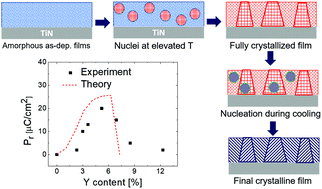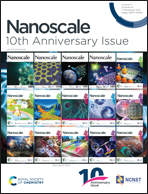Understanding ferroelectric phase formation in doped HfO2 thin films based on classical nucleation theory†
Abstract
Ferroelectricity in doped HfO2 thin films has attracted increasing attention since 2011. The origin of the unexpected ferroelectric property is now accepted as the formation of the noncentrosymmetric Pca21 orthorhombic phase. However, the mechanism for the ferroelectric phase formation is still under debate. In this paper, the classical nucleation theory is revisited to understand the ferroelectric phase formation in doped HfO2 thin films. From nucleation theory, it can be identified that there is an appropriate doping concentration range for the ferroelectric phase formation. The doping concentration should be sufficiently high to suppress the monoclinic phase formation during the crystallization annealing process. Once the stable monoclinic phase is formed, the transformation into the other metastable phases is improbable. For appropriate doping concentrations, a transition to the second most stable tetragonal phase is kinetically enhanced, whereas that to the most stable monoclinic phase is kinetically suppressed at the annealing temperature. During cooling, the transition of the tetragonal phase to the second most stable orthorhombic phase is kinetically enhanced, whereas that to the most stable monoclinic phase is suppressed near room temperature. However, the doping concentration should not be too high. Otherwise, the tetragonal phase formed during the crystallization annealing process cannot be transformed into the ferroelectric orthorhombic phase during cooling. This is because high doping concentration lowers the transition temperature and makes the transition reaction difficult. The appropriate doping concentration range is dependent on the types of dopants, but the general governing process was the kinetic nucleation of the tetragonal phase during crystallization and its transformation into the ferroelectric orthorhombic phase during cooling.

- This article is part of the themed collection: Nanoscale 10th Anniversary Special Issue


 Please wait while we load your content...
Please wait while we load your content...